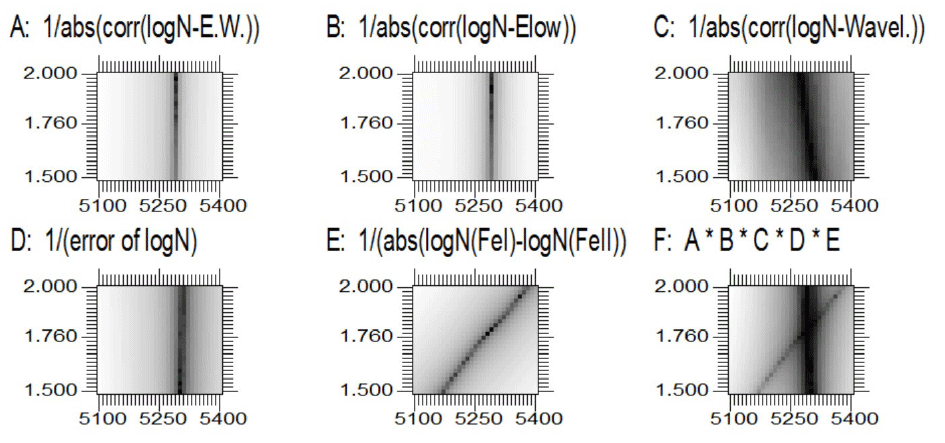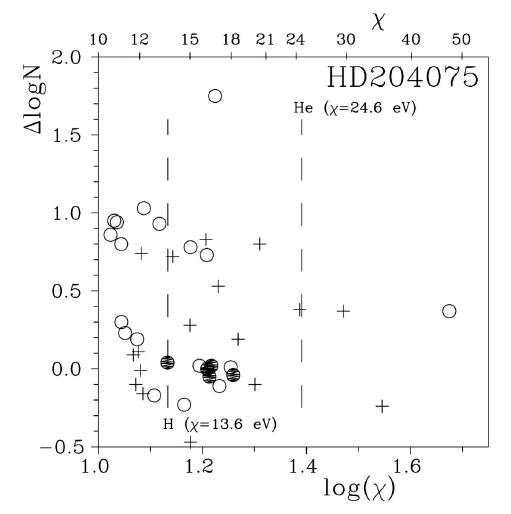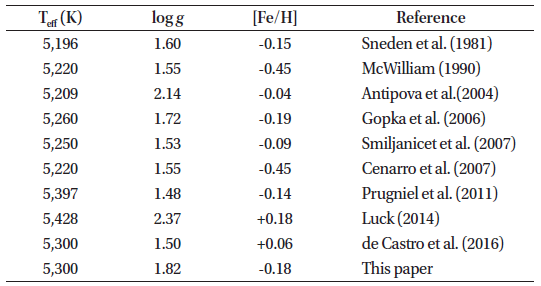1. INTRODUCTION
In this paper we refine the atmospheric parameters and atmospheric iron abundance of the main component of barium star HD204075 (ζ Capricornus), using high quality spectral observations, modern software and updated atomic line databases. We analyzed previously published abundances of chemical elements in the main component of this barium star (Antipova et al. 2004;Gopka et al. 2006) to examine the possibility of hydrogen and helium accretion from the interstellar environment.
The reactions of hydrogen atoms with the first ions of chemical elements in the atmospheres of metallic-line stars was first proposed by Greenstein (1949) as an explanation for observed underabundances of elements with second ionization potentials close to the ionization potential of hydrogen (13.6 eV), detected in the atmospheres of these stars. Greenstein (1949) explained the underabundances by charge-exchange reactions between the first ions of these elements and hydrogen atoms in stellar atmospheres. As a result of these reactions, the first ions of these elements lose one more electron, become the second ions, and, after obtaining a great enough kinetic energy, are pushed out of the photosphere, creating the observed deficiency.
Greenstein (1949) proposed that charge-exchange reactions can have a resonance for elements with second ionization potentials close to 13.6 eV. This explains why these elements should be effectively deleted from the photosphere and their abundances (relative to solar) can be significantly lower than the abundances (relative to solar) of other chemical elements whose second ionization potentials are not close to the resonance value. Greenstein (1949) found a decrease of abundance for elements with second ionization potentials between 12 and 16 eV and estimated the width of the resonance to be of the order of 4 eV.
If energy transfer in the photosphere is mostly radiative, any type of anomaly can remain for a long time (Michaud 1970). When energy transfer is mostly convective, any anomalies of chemical abundances in the photosphere should quickly disappear. The barium star HD204075 is a red giant and exhibits mostly radiative energy transfer. Consequently, long-term maintenance of any changes in chemical composition of its photosphere is to be expected.
Havnes (1970, 1971) proposed that hydrogen atoms can accrete from the interstellar environment and this pushes the first ions with proper second ionization potential not only out of the photosphere, but also out of the star. These ions can also decrease the rotational energy of the star and can significantly increase the period of stellar rotation. These charge-exchange reactions were also noted as a possible mechanism for the production of low energy (energies less than 200 MeV/nucleon) galactic cosmic rays. Böhm-Vitense (2006) observed evidence of this effect not only for hydrogen but also helium. She found the underabundances of chemical elements with second ionization potentials close to the first ionization potential of helium (24.6 eV). Yushchenko et al. (2015) reviewed the features of this phenomenon for B-F type single stars and Jeong et al. (2018) reviewed them for barium type stellar binaries.
Yushchenko et al. (2015) and Jeong et al. (2018) used the published abundances for usual stars with low magnetic fields and detected this phenomenon for all objects, including objects located in regions with a low density of interstellar matter. Consequently, we expect that underabundances can be a result of the interaction of a stellar photosphere with low density interstellar matter, with the duration of such interaction being in the order of the star’s life time. Even weak magnetic fields can be sufficient for producing anomalous chemical compositions over long time intervals. It is important to establish the lower limit of this time interval and we provide an estimate here.
This type of accretion manifests itself in the correlations between the relative abundances of chemical elements and the second ionization potentials of these elements, as compared to solar. The theory of this effect has not been developed in detail in previously published studies.
Proffitt & Michaud (1989) discussed accretion from the evolved components of binary systems in combination with radiative diffusion (Michaud 1970). In contrast to radiative diffusion, the accretion of hydrogen and helium is not widely accepted as a possible explanation of chemical anomalies in stellar atmospheres. The investigation of this accretion in different types of stellar atmospheres will help to develop or to reject the theory proposed by Havnes (1970, 1971) and Havnes & Conti (1971) for stars with strong magnetic fields and possibly extend it for the case of stars with weak magnetic fields.
As part of this study, we used the published abundance patterns of HD204075 to estimate the time limits on the creation of anomalies in chemical abundance, which can be produced by the accretion of hydrogen and helium from the interstellar environment. These are the deficiencies of relative (to solar atmospheric values) abundances of chemical elements with second ionization potentials close to the ionization potentials of hydrogen and helium (13.6 eV and 24.6 eV respectively).
2. THE SPECTRUM USED AND ABUNDANCE ANALYSIS
The high-resolution spectrum of HD204075 was taken from the public archive of the European Southern Observatory (Bagnulo et al. 2003). The signal to noise ratio of the spectrum exceeds 300, the resolving power is equal to R = 80,000 and the wavelength coverage ranged from 3,040– 10,400 Å. URAN code (Yushchenko 1998) was used to place the continuum, to identify spectral lines and to measure the equivalent width of these lines.
To determine the continuum level and to identify the various lines, the updated version of the suite of codes known as the SYNTHE code, developed by Kurucz in 1993, was used to generate the synthetic spectrum for the whole region of the observed wavelengths. Line data were taken from the, Hirata & Horaguchi (1995) line list, Fuhr & Wises (2006), and the Kurucz (1993), VALD (Piskunov et al. 1995), Morton (2000), and DREAM (Biémont et al. 2002) databases, as well as other sources. The clean and not strongly blended lines in the observed spectrum were selected on the basis of comparisons with synthetic spectrum. Synthetic spectrum was calculated for the whole wavelength region covered by observations. More details about the calculation procedure can be found in Yushchenko et al. (2015) and Kang et al. (2012, 2013).
To find the effective temperature, surface gravity, metallicity, and iron abundance of HD204075, the method developed by Yushchenko et al. (1999) and Gopka et al. (2004), was used. This method uses the iron abundances calculated for different spectral lines using atmosphere grid models and micro-turbulent velocities. The steps in effective temperature and surface gravity should be selected to be less or equal to the expected precision of the determination of parameters. For each model, calculations of abundance were made with different values of microturbulent velocities. Usually the calculations for two grids, constructed using interpolation with different steps in effective temperature and surface gravity, were sufficient. Interpolation was necessary because the grid sizes of atmospheric models were not sufficiently precise.
The analysis of calculations of abundance for a grid of atmospheric models allows selection of the best parameters. The results of the last iteration are shown in Fig. 1. The grid of atmospheric models for this calculation with effective temperatures from Teff = 5,100 K to Teff = 5,400 K (step size 10 K) and surface gravities from log g = 1.5 to log g = 2.0 (step size 0.02) were prepared by interpolation of Kurucz (1993) atmosphere models. A detailed description of methods can be found in Kang et al. (2012, 2013). The true values of effective temperature and surface gravity should be near the intersections of dark edges in panel F of Fig. 1. This region is limited by surface gravities 1.78 < log g < 1.86 and effective temperatures 5,280 K < Teff < 5,320 K. The values Teff = 5,300 ± 50 K and log g = 1.82 ± 0.15 were selected. The pointed errors exceeded the steps of the grid of atmospheric models used in the last iteration and include possible systematic errors. The best micro-turbulent velocity of the atmosphere model with these parameters was vmicro = 2.52 ± 0.10 km/s, the iron abundance calculated using 105 lines of neutral iron and 31 lines of singly ionized iron was log N (Fe) = 7.32 ± 0.06 (in the scale log N (H) = 12). This iron abundance corresponds to [Fe/H] = –0.18 if the solar iron abundance was set to logN (Fe) = 7.50 (Asplund et al. 2009). Alternatively, [Fe/H] = –0.15 if we accept the solar value logN (Fe) = 7.47 (Scott et al. 2015).

Table 1 shows the list of iron lines used in this study. The first two columns of Table 1 are the wavelength and the line identification; the third through sixth column are the equivalent width, measured in milliangstroms (mÅ); next are the oscillator strength and low level energy, measured in electron-volts (eV); and, finally, the derived abundances, measured in the scale logN (H) = 12. Table 2 compares the parameters of HD204075 main component previously published, and our values.
3. DISCUSSION
Our values of effective temperature, surface gravity, and metallicity are within the typical error boxes of previously published values (Table 2). We will use our values to estimate the homogeneous set of abundances of chemical elements in the atmosphere of HD204075 and to compare previously published abundances for this barium star and the second ionization potentials of corresponding elements. This comparison allows us to confirm or reject the existence of the influence of accretion of hydrogen and helium from the interstellar environment. Such accretion was discussed by Greenstein (1949), Bohm-Vitense (2006), and Yushchenko et al. (2015).
We adopted the abundances of chemical elements in the photosphere of HD204075 from Antipova et al. (2004) and Gopka et al. (2006) and plot these against the second ionization potentials of chemical elements (Fig. 2). No clear correlations were apparent in this plot.

A comparison Fig. 2 of this paper with Fig. 6 in Yushchenko et al. (2015) and also with Fig. 1 in Jeong et al. (2018), where similar dependencies were shown for δ Sct type star ρ Pup and barium type star ζ Cyg, respectively, demonstrates that the dependencies described in these two papers, are not found in the atmosphere of HD204075. The most important of these non-detected dependencies is the correlation of the abundance of chemical elements against the second ionization potentials of these elements having second ionization potentials between 13.6 and 24.6 eV (the ionization potentials of hydrogen and helium respectively).
Let us accept that the accretion of interstellar hydrogen and helium from the interstellar environment in the atmospheres of ρ Pup and ζ Cyg was responsible for the correlations of relative abundances versus second ionization potentials. These correlations were not detected in HD204075. Therefore, evidence of accretion of interstellar or circumstellar hydrogen and helium was not found in the atmosphere of HD204075 and, so, other physical effects must be responsible for the abundance anomalies in this star-namely for overabundances of s-process elements.
Fig. 2 from Gopka et al. (2006) shows the strong influence of the accretion of nuclear-processed matter from the former red giant companion (now a white dwarf ) to the atmosphere of another binary component, a modern red giant. This process is the usual explanation for chemical anomalies in barium stars. The accretion from the former red giant clearly changes the surface chemical abundances of a modern red giant and in stars with radiative atmospheres, including red giant stars, these changes remain for long time.
After the transition of a former red giant to a white dwarf, additional physical effects can be important for the production of chemical anomalies in other binary component, namely, modern red giant. One of these effects can be the accretion of hydrogen and helium from interstellar space. It is likely that the significance of this effect increases with time after the creation of a white dwarf companion. Jeong et al. (2018) determined the age dependence of the correlation of chemical abundances versus second ionization potentials in barium stars, as shown in the bottom panel of Fig. 4 in Jeong et al. (2018). Correlations were found for six chemical elements, namely, Al, Si, Ti, Cr, Fe, and Ni. Five of these elements (excluding Al) are marked in Fig. 2 of the current paper. Antipova et al. (2004) did not find the aluminum abundance; hence it is better to use the de Castro et al. (2016) survey, where the abundances of all six elements were found for HD204075.
The correlation coefficient of abundances of these elements (including Al) versus their second ionization potentials was 0.46±0.32 if we use the abundances calculated by de Castro et al. (2016). The age of HD204075 is 107.8 years (de Castro et al. 2016). HD204075 is one of the youngest barium stars in the de Castro et al. (2016) survey. The age and correlation coefficient of HD204075 place it in the upper left corner of the bottom panel in Fig. 4 of Jeong et al. (2018) and corresponds to objects with minimum age and close to zero correlation coefficient of abundances versus second ionization potentials for the six chemical elements listed above. Taking into account the age of HD204075, the absence of evidence of hydrogen and helium accretion from interstellar medium, (Fig. 2), is therefore not surprising.
Havnes (1970, 1971) demonstrated that the accretion of hydrogen from interstellar medium can significantly change elemental abundances on stellar surfaces on the time scales of 108 years for hot stars with strong magnetic fields. Barium stars do not have strong magnetic fields and therefore the effects of hydrogen accretion should be important at longer time-scales. The bottom panel of Fig. 4 of Jeong et al. (2018) illustrates the possible influence of hydrogen accretion on the time scale from 107.9 to 109.6 years.
The young age of HD204075 can be confirmed by detection of technetium lines in the spectrum of its atmosphere (Gopka et al. 2006). Technetium (Tc) has no stable isotopes, the longest half-life is of the order of 105 years for Tc99. Detection of this element confirms the recent transfer of nuclear processed matter from the evolved binary companion to the atmosphere of the modern red giant companion.
The main conclusion of this paper is that the accretion of hydrogen and helium atoms from the interstellar environment to the atmosphere of young barium star HD204075 produces no detectable anomalies of chemical composition over the past 105 to 108 years. For stars with weak magnetic fields, including HD204075, this type of accretion can be significant at time scales longer than 108 years.
This conclusion was not based on a detailed theory of hydrogen and helium accretion from interstellar medium to the atmospheres of normal stars with only a weak magnetic field, this theory, now only the hypothesis, should be developed in the future. Before doing so, however, it is necessary to collect observations which can be used to confirm or reject this hypothesis for different types of stars.

